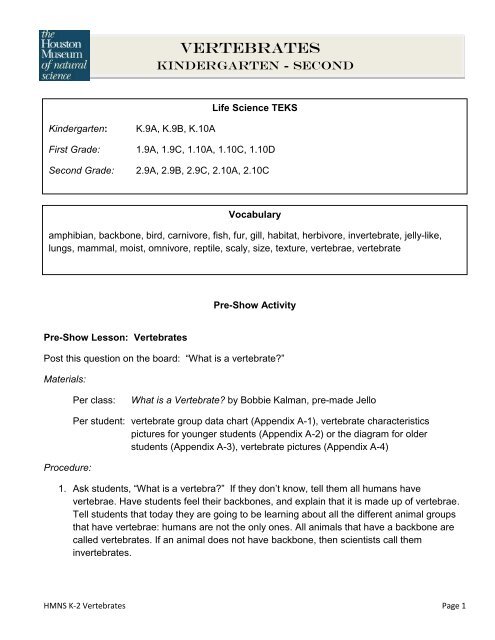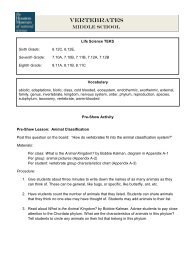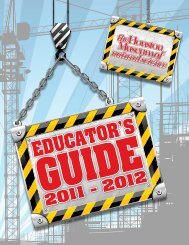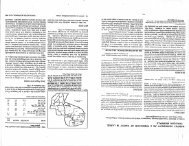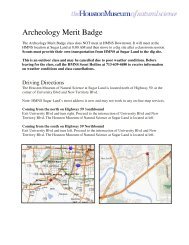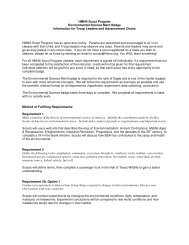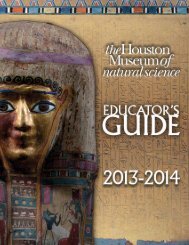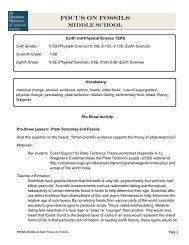VERTEBRATES
VERTEBRATES
VERTEBRATES
- No tags were found...
Create successful ePaper yourself
Turn your PDF publications into a flip-book with our unique Google optimized e-Paper software.
Oh Vertebrates, Oh Vertebrates,There are five kinds of Vertebrates.Reptiles, birds and amphibians,Mammals, fish – let’s sing again.Oh Vertebrates, Oh Vertebrates,There are five kinds of Vertebrates.Source: http://www.brighthubeducation.com/lesson-plans-grades-1-2/64882-categories-ofvertebrates/Activity Three: Vertebrae ModelMaterials:Per child: chenille stem (pipe cleaner), wagon-wheel pasta, uncooked*candy gelatinrings (like Life-Saver gummies)Procedure:1. Bend one end of the chenille stem so that the pasta cannot fall through. Put six piecesof wagon-wheel pasta through the stem down toward the bent end. Bend the stemabove the pasta to hold the pasta in place.2. Bend and twist the stem. What do you see and hear?3. Take all the pasta off the stem except one. Place a gelatin ring on the pasta. Alternatebetween pasta and gelatin ring.4. Add pasta and rings until the stem is almost full. Bend the stem above the pasta andrings to hold them in place.5. Bend and twist the stem. What do you hear?6. Draw pictures of the model backbones you made. Compare your model with a pictureof a real backbone. This can be found in the science text book, reference book, or online.What does each part of your model stand for? What is the purpose of each part?What parts are missing from the model? How could you improve this model?Teacher Information:Vertebrae: The spine is a column of small bones, or vertebrae, that support the entire upperHMNS K-2 Vertebrates Page 4
ody. The column is grouped into three sections of vertebrae:Cervical © vertebrae are the seven spinal bones that support the neck.Thoracic (T) vertebrae are the 12 spinal bones that connect to the rib cage.Lumbar (L) vertebrae are the five lowest and largest bones of the spinal column. Mostof the body’s weight and stress falls on the lumbar vertebrae.Each vertebra can be designated by using a letter and number; the letter reflects the region(C=cervical, T=thoracic, and L=lumbar), and the number signifies its location within thatregion. For example, C4 is the fourth bone down in the cervical region, and T8 is the eighththoracic vertebra.Below the lumbar region is the sacrum, a shield-shaped bony structure that connects withthe pelvis at the sacroiliac joints. At the end of the sacrum are two to four tiny, partially fusedvertebrae known as the coccyx or “tail bone.”The Disks. Vertebrae in the spinal column are separated from each other by small cushionsof cartilage known as intervertebral disks. Inside each disk is a jelly-like substance called thenucleus pulposus, which is surrounded by a tough, fibrous ring called the annulus fibrosis.The disk is 80% water. This structure makes the disk both elastic and strong. The disks haveno blood supply of their own, relying instead on nearby blood vessels to keep themnourished.Spinal cord: A column of nerve tissue that runs from the base of the skull down the back. Itis surrounded by three protective membranes, and is enclosed within the vertebrae (backbones). The spinal cord and the brain make up the central nervous system, and spinal cordnerves carry most messages between the brain and the rest of the body.Source: University of Maryland Medical CenterActivity Four: MammalsMaterials: Animals Born Alive and Well by Ruth Heller, sticky notesProcedure:1. Read Ruth Heller’s book Animals Born Alive and Well.2. Provide sticky notes with the name of each animal discussed. Older students canwrite these themselves as the animals are mentioned in the book.3. Have students sort sticky notes.Students can sort the sticky notes by:HMNS K-2 Vertebrates Page 5
Mammals that live on land, water or flyMammals that eat plants (herbivores), animals (carnivores) or both (omnivores)Mammals that have live birth and mammals that lay eggs (spiny ant eater and the platypus)Mammals that live in a desert, ocean, forest or polar regionMammals with gills, mammals with lungs (This is a trick question, no mammals have gills.)For younger students, you may need to do this as a class.Activity Five: BearsMaterials: stuffed bear or bear picture, Bears: Polar Bears, Black Bears and Grizzly Bears (KidsCan Press Wildlife Series), chart paperProcedure:Students will need to bring a stuffed bear from home before participating in this activity. If they donot have one, they can bring a picture of a bear. All students will sit in a circle on the carpet in thefront of the room with their bears.1. Ask students what they know about bears.2. Ask students to turn and talk to their neighbor, describing their bear: color, size, texture,type of bear, body features, etc. Partner A will go first. After one minute, partner B will talk.Discuss observations as a class. Are they good models of a real bear? Why or why not?3. Have students put all their bears in front of them. Ask: “What colors are the bears?” Havekids one by one put their bear next to a bear that matches their bear’s color until all likecolored bears are together. Ask students why real bears have different colors. Which bearswould probably live in a cold area? Why? Which bears would probably live in the forest?Why? Which color group has the most bears? What color group has the fewest bears?4. Remind students of what they already know about bears; that they are vertebrates,mammals, etc. Ask students if they have questions about bears. Record some of theirquestions on chart paper.5. Tell students that you are going to read a book about bears and that they are going to lookfor the answers to their questions. If they hear an answer, they will raise their hand and youwill write it on the paper in a different color.6. Read Bears: Polar Bears, Black Bears and Grizzly Bears (Kids Can Press Wildlife Series)by Deborah Hodge and Pat Stephens. As you read, put answers to your questions aboutHMNS K-2 Vertebrates Page 6
ears up on the chart paper. Be sure that you have covered all the characteristics of bearsthat make it a mammal.7. Ask kids which real-life bear their stuffed bear is a model of. Have them turn and talk to theirneighbor and tell them at least one thing that they learned about their bear.HMNS K-2 Vertebrates Page 7
AppendixA-1Vertebrate MatCharacteristics of Group:BirdsAnimals in Group:FishReptilesHMNS K-2 Vertebrates Page 8
AmphibiansMammalsHMNS K-2 Vertebrates Page 9
A-2 Vertebrate Characteristic CardsHow does it breathe?Lungs Lungs Lungs LungsGillsGillsWhat kind of skin does it have?Hair or furScaleySkinScaleySkinFeathersSmooth andMoistSkinHow does it reproduce?Hard shelledEggHard shelledEggJelly like EggsJelly like EggsLive BirthHMNS K-2 Vertebrates Page 10
Mother milks youngGraphic Sources:Lungs: teacherresourcesgalore.comFish gills: Arthur’s clip artScaley skin: raguett.hubpages.comHair: fotosearch.comFeathers: themeanings.comJello: seeswhilesitting.comEgg: school.discoveryeducation.comFish eggs: billybear4kids.comBaby: faithclipart.comMilk: usmessageboard.comHMNS K-2 Vertebrates Page 11
A-3Vertebrate Characteristics DiagramCopycat Page from National Wildlife Federation, Nature Scope - Amazing Animals, Part I, 1988HMNS K-2 Vertebrates Page 12
A-4Vertebrate Pictures:All pictures are from Arthur’s Clipart: http://www.arthursclipart.org/index%20comp.htmHMNS K-2 Vertebrates Page 13


